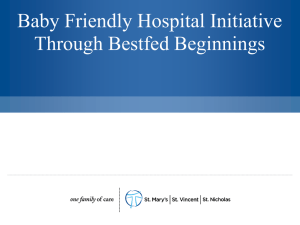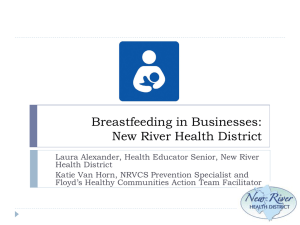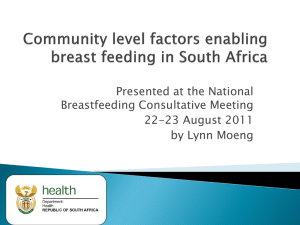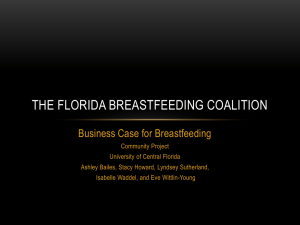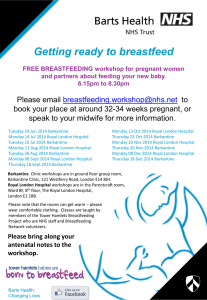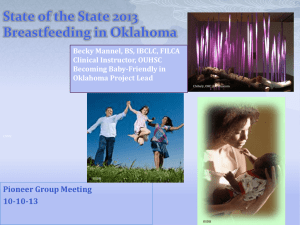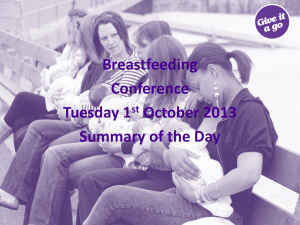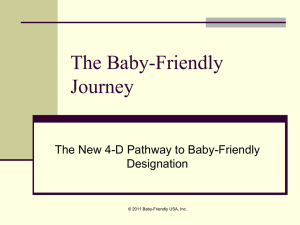Breastfeeding Friendly Child Care Center Training
advertisement
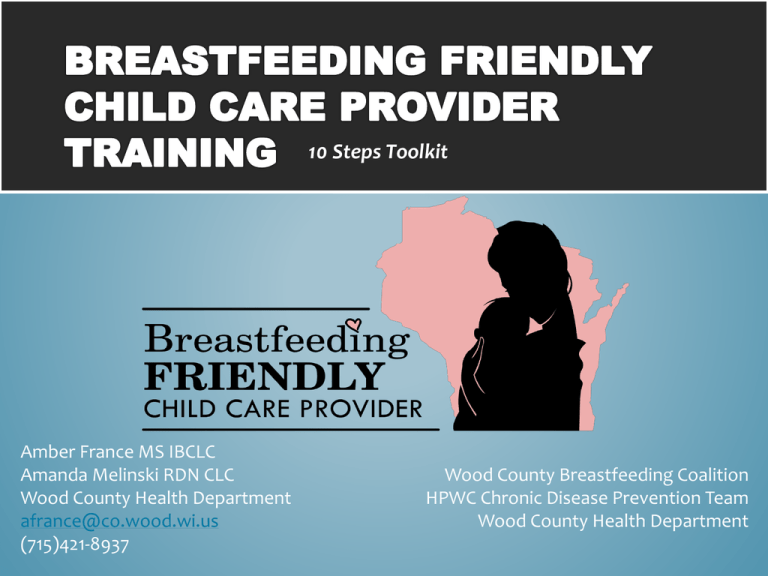
10 Steps Toolkit Amber France MS IBCLC Amanda Melinski RDN CLC Wood County Health Department afrance@co.wood.wi.us (715)421-8937 Wood County Breastfeeding Coalition HPWC Chronic Disease Prevention Team Wood County Health Department • Investing Early Grant from Celebrate Children Foundation • Develop Training/Materials • Process • Outcomes Awareness • • • • • • • • • • • • Lower IQ Increased risk of SIDS Increase in infectious illness Higher risk of inflammatory bowel diseases Increase NEC in preemies Higher risk of cancer Higher risk for cardiovascular disease Higher risk of diabetes No protection from asthma & eczema Higher risk of childhood obesity More cavities Problems with oral/jaw structure • • • • • Life is easier Saves money Feel great Health benefits Miss less work “If 90 percent of families breastfed exclusively for 6 months, nearly 1,000 deaths among infants could be prevented.” • Save $13 billion per year • More productive workforce • Better for environment • • • • Babies are sick less Babies are happier Diaper odor is less Baby may spit up less • Easier transition • More marketable • Breastmilk is part of the Meal Pattern – Reimbursable component of infant meal pattern – Children >12 months, breastmilk substitute cow’s milk in the meal pattern for reimbursement Duration Healthy People 2020 Goals Wisconsin (2009) Initiate breastfeeding 81.9% 75.5% At 6 months 60.6% 48.6% At 1 year 34.1% 25.9% Exclusively for 3 months 46.2% 45.2% Exclusively for 6 months 25.5% 16.8% • Increase the proportion of employers that have worksite lactation support programs • Exclusive breastfeeding for the 1st 6 months • Continued breastfeeding through at least the 1st year or longer as mutually desired • Medical contraindications are rare WHO recommends at least 2 years! “One of the most highly effective preventive measures a mother can take to protect the health of her infant and herself is to breastfeed.” “The success rate among mothers who want to breastfeed can be greatly improved through active support from their families, friends, communities, clinicians, health care leaders, employers, and policymakers.” • Step 1: Designate an individual or group who is responsible for development and implementation of the 10 steps. • Step 2: Establish a supportive breastfeeding policy and assure that all staff are aware of and following the policy. • Step 3: Establish a supportive worksite policy for staff members who are breastfeeding. • Step 4: Train all staff so that they are able to carry out breastfeeding promotion and support activities. • Step 5: Create a culturally appropriate breastfeeding friendly environment. • Step 6: Inform expectant and new families and visitors about your Center’s breastfeeding friendly policies. • Step 7: Stimulate participatory learning experiences with the children related to breastfeeding. • Step 8: Provide a comfortable place for mothers to breastfeed or pump their milk in privacy, if desired. Educate families and staff that a mother may breastfeed her child wherever they have legal right to be. • Step 9: Establish and maintain connections with your local breastfeeding coalition or other community resources. • Step 10: Maintain an updated resource file of community breastfeeding services and resources kept in an accessible area for families. • • • • Reviews existing practices Compliance with requirements Assess key areas for improvement Tool to prioritize Designate an individual or group who is responsible for development and implementation of the 10 steps. • Designate individual or small group to – Initiate & asses progress – Review policies, procedures, & protocols – Ensure staff receive orientation & training • • • • • • • Support from Management & Staff Assemble team Designate a coordinator Team meetings Planning Action Plan Continuing Education • • • • • 75% women employed with children <3 years 51% under 2 cared for by someone other than parent Child care vital role in breastfeeding Benefits to family & center Child care setting: Natural, logical place for support • • • • Depend on size of center Both management and direct staff Designate a coordinator Team meetings • Written guidance • Example in tool-kit Establish a supportive breastfeeding policy and assure that all staff are aware of and following the policy. • Support & protect mothers/infants • Addresses – Breastfeeding mothers welcome – Accurate information – Trained staff • Sample policies Establish a supportive worksite policy for staff members who are breastfeeding. • • • • Supportive staff Comfortable environment Supporting employees Example lactation areas Train all staff so that they are able to carry out breastfeeding promotion and support activities. • Store in 1-4 oz. portions • Label milk – Infants full name – Date – Amount • Discuss with parents • Use Academy of Breastfeeding Medicine Storage Guidelines Example: Sammy Smith Date pumped: 12/12/12 Amount: 4 oz. Location Duration Room Temperature 6-8 Hours Insulated Cooler 24 Hours Refrigerator 5 Days Freezer Compartment in Refrigerator 2 Weeks Freezer Compartment of Refrigerator with Separate Doors 3-6 Months Deep Freezer (Freezer Chest) 6-12 Months *The Academy of Breastfeeding Medicine (Protocol #8) • Separation • Swirl – Don’t shake • Thaw – Refrigerator – Under warm water • Do not refreeze • Do not use a microwave • Use warm water – Under running water – In container of warm water – Bottle warmer • Excessive heat destroys properties • Some like cold milk • • • • Easily digested Typically 1 ½ to 3 hours Hunger cues Avoid large feedings • Growth Spurts • Needs as baby grows • Breastmilk vs formula composition • • • • • Mimic breastfeeding Switch arms Baby control feeding Feed slowly Stop with baby’s cues • Reverse Cycle Feeding • Different Containers • Weight gain – Most Important • Wet diapers • Spit up is normal • Not good indicators – Baby cries after feedings – Mom can only pump ½ ounce – Baby will continue to take more milk after first bottle • Mustard color • Seedy • Runny to pudding consistency • Normal not to stool daily • Supply and demand • Low supply triggers – Supplements – Skipping Feedings – Pacifiers – Illness • Referral to Lactation Consultant • To Increase (at center) – Give only what was pumped the previous day – Do not supplement • To Increase (with mom) – No pacifiers – Nurse more often – Do not skip pumping at work • No need for separate refrigerator • No gloves • Not contaminated by touch *According to OSHA’s and CDC’s definitions, breastmilk is classified as “food” and does not require universal precautions for handling body fluids. • Verbalize and initiate support • Encourage mom to get help • Be accommodating • Staff develop with family • Individualize • Familiarize all staff • Delay solids until around 6 months – AAP guidelines • Good starters Create a culturally appropriate breastfeeding friendly environment. • • • • • Written and verbal communication Eliminate/limit visibility of formula No baby bottle pictures Racial/ethnically diverse pictures & materials Monitor staff Inform expectant and new families and visitors about your Center’s breastfeeding friendly policies. • Breastfeeding policies and handouts • Information on local laws • Signage Stimulate participatory learning experiences with the children related to breastfeeding. • Books • Pictures Provide a comfortable place for mothers to breastfeed or pump their milk in privacy, if desired. Educate families and staff that a mother may breastfeed her child wherever they have legal right to be. Wisconsin State Statute 253.16 “A mother may breastfeed her child in any public or private location where the mother and child are otherwise authorized to be. In such a location, no person may prohibit a mother from breastfeeding her child, direct a mother to move to another location to breastfeed her child, direct a mother to cover her child or breast while breastfeeding, or otherwise restrict a mother from breastfeeding” Establish and maintain connections with your local breastfeeding coalition or other community resources. Maintain an updated resource file of community breastfeeding services and resources kept in an accessible area for families. • Your local breastfeeding coalition will update you on the latest breastfeeding information. RESULTS Area Assessed Baseline (3/2013) Post (4-5/2013) BF Environment 19.5 25.2 BF Support Practices 21.3 26 BF Education & Prof Development 11.6 24.2 BF Policy 6.7 24 Infant Foods Served 27.8 26 Infant Feeding Practices 26.3 26 Infant Feeding Education & Prof Development 19 22.8 Infant Feeding Policy 14.7 23.3 Average Baseline: 18.2 Average Post: 24.8 RESULTS 30 25 20 Avg. Score (Pre) 15 Avg. Score (Post) 10 5 0 1 2 3 4 5 6 7 8 9 10 11 12 13 14 15 16 17 All Sites CCR&R LISTING EMBLEM Amber France MS IBCLC Wood County Health Department afrance@co.wood.wi.us (715)421-8937 WEBSITE www.woodcountybreastfeeding.org REFERENCES • • • • • • • • http://www.cdph.ca.gov/programs/breastfeeding/Documents/MO -HowDoesForWAFBF-Eng.pdf http://infantnutritioncouncil.com/breastmilk-information/ http://www.americanpregnancy.org/firstyearoflife/whatsinbreast milk.html http://www.womenshealth.gov/breastfeeding/whybreastfeeding-is-important/index.html http://www.usbreastfeeding.org/Portals/0/Publications/ChildCare-2002-USBC.pdf http://digitalcommons.unl.edu/cgi/viewcontent.cgi?article=1007& context=sociologydiss&seiredir=1&referer=http%3A%2F%2Fwww.google.com%2Furl%3Fsa%3Dt %26rct%3Dj%26q%3Dbenefits%2520of%2520breastfeeding%2520to%2 520childcare%2520centers%26source%3Dweb%26cd%3D4%26ved%3D 0CFEQFjAD%26url%3Dhttp%253A%252F%252Fdigitalcommons.unl.ed u%252Fcgi%252Fviewcontent.cgi%253Farticle%253D1007%2526conte xt%253Dsociologydiss%26ei%3DAKPPULXbHoakyQG5q4HYCQ%26us g%3DAFQjCNGykr2msusoayso3sdiQCL2FosR_A#search=%22benefit s%20breastfeeding%20childcare%20centers%22 http://www.dhs.wisconsin.gov/hw2020/health/nutrition/reportca rd09.pdf http://kellymom.com/bf/normal/growth-spurts/ REFERENCES • • • • • • • • • • • http://www.workandpump.com/reversecycling.htm http://www.nbci.ca/index.php?option=com_content&view=articl e&id=23:is-my-baby-getting-enoughmilk&catid=5:information&Itemid=17 http://www.mayoclinic.com/health/low-milk-supply/AN02187 http://kellymom.com/bf/got-milk/supply-worries/low-supply/ http://www.osha.gov/pls/oshaweb/owadisp.show_document?p_t able=INTERPREATIONS&p_id=20952 http://kellymom.com/nutrition/starting-solids/solids-how/ http://mchb.hrsa.gov/pregnancyandbeyond/breastfeeding/ http://wdrs.fnal.gov/elr/familybalance/mothersroom.html http://uvahealth.com/directions-locations/clinics/images-anddocs/augusta-pediatrics-indoor-shots/nursing%20room.jpg/view http://www.meadjohnson.com.ph/news_lactation-suite-room-fornourishment.html http://rakhealthmatters.wordpress.com/2012/03/21/breastfeeding -and-the-milk-supply-over-time/
